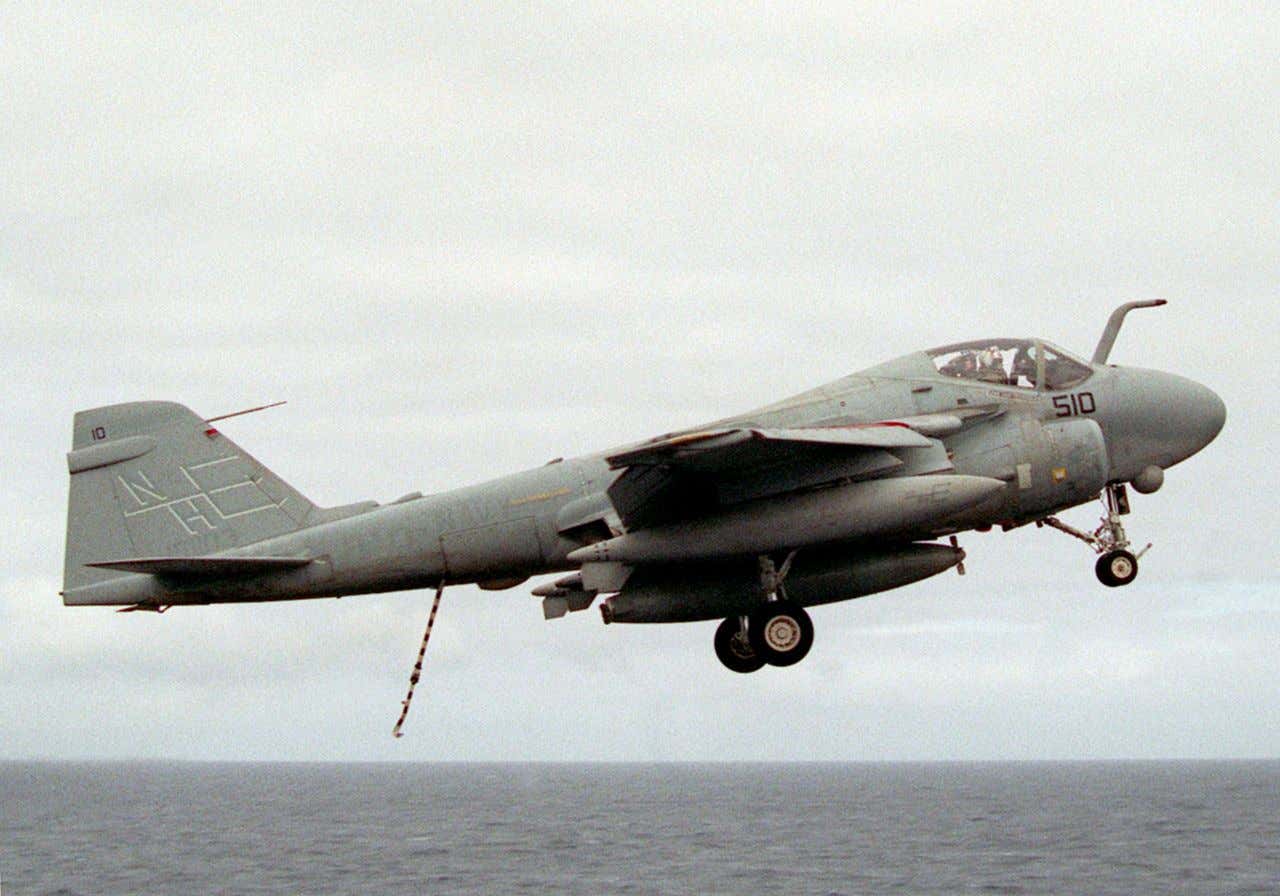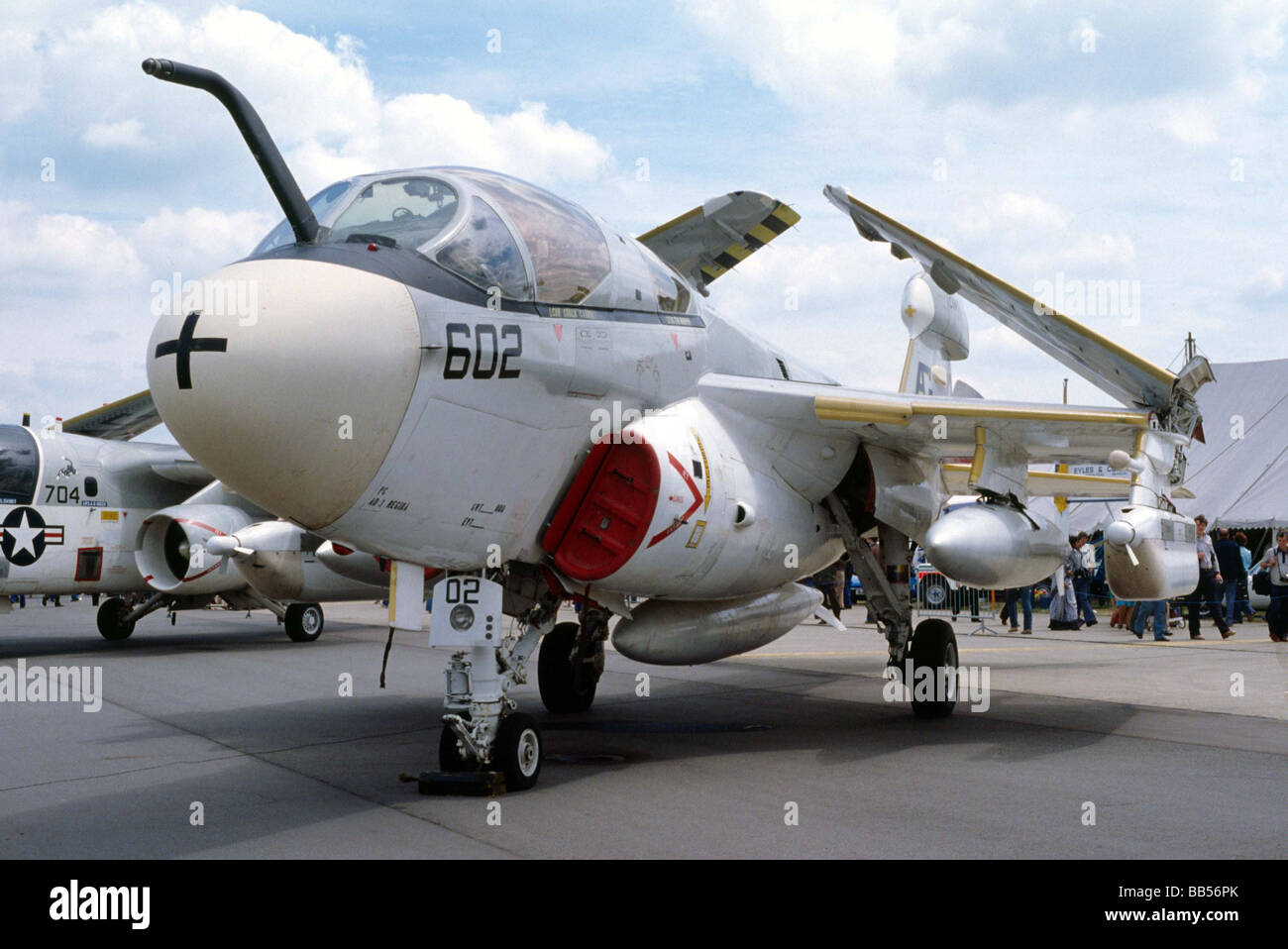A 6a Intruder - The Grumman A-6 Intruder is an American all-weather twinjet attack aircraft developed and manufactured by the American aircraft company Grumman Aerospace and operated by the United States Navy and United States Marine Corps.
It was designed in response to a 1957 request from the Bureau of Aeronautics for an all-weather attack aircraft for long-haul naval missions and with short take-off and landing (STOL) capabilities for close Navy support. It was to replace the Douglas A-1 Skyraider with piston rings. Requirements allowed for one or two gins, either turbojet or turboprop.
A 6a Intruder

Grumman's winning design used two Pratt turbojet engines and a Whitney J52. The Intruder was the first naval aircraft to have an integrated airframe and weapon system. Operated by a crew of two in a side-by-side seating arrangement, the task is divided between the pilot and the weapons officer (bombardier / navigator (BN)). In addition to traditional weapons, you can also carry nuclear weapons, which will be delivered using a bomb blast. On April 19, 1960, the first prototype made its first flight.
Grumman A 6 Intruder Mj
The A-6 was in service with the United States Navy and Marine Corps between 1963 and 1997, during which time many variants were designed and produced. Two of the more successful variants developed were the EA-6B Prowler, a special electronic warfare variant, and the KA-6D tanker version.
It saw service during several overseas conflicts, including the Vietnam War and the Gulf War. The A-6 was to be replaced by the McDonnell Douglas A-12 Avger II, but this program was eventually canceled due to cost concerns. So when the A-6E was retired, its precision strike mission was first taken over by a Grumman F-14 Tomcat equipped with a LANTIRN capsule.
Due to the fair-weather limitation of the propeller-driven Skyraider in the Korean War and the advent of turbines, the United States Navy issued preliminary requirements for an all-weather aircraft in 1955. The United States Navy published a request a job was given in October 1956. In February 1957, it issued a request for proposals (RFP).
This request calls for an "air-supported bomb capable of striking emy at any time." Aviation writers Bill Gunston and Peter Gilchrist note that this specification was shaped by operational experiences in the Korean War, during which close air support was often unavailable unless weather conditions were favorable.
Tailhook Topics: Grumman A 6a Vs A 6e Intruder
In total, design proposals were submitted by eight different companies in response to the RFP, including Bell, Boeing, Douglas, Grumman, Lockheed, Martin, North American, and Vought.
After evaluating bids, the United States Navy announced the selection of Grumman on January 2, 1958. The company was awarded a contract in February 1958 to develop their entry, which was redesignated the A2F-1.
Mead later played a major role in the design of the Lunar Excursion Module and the Grumman F-14 Tomcat.

The group is spread across two locations, headquarters in Bethpage and testing facilities at the Naval Weapons Production Reserve Center, Calverton. In September 1959, the design was approved by the Mock-Up Review Board.
Grumman A 6e Intruder By Bagera3005 On Deviantart
The A2F-1 design incorporated many advanced features for the time. In the early 1960s, it was a novelty for a fighter-sized aircraft to have advanced electronics using multiple computers. This design experience was considered by NASA in their November 1962 decision to select Grumman over other companies such as General Dynamics-Convair (the F-111 had automated avionics capabilities similar to the A-6, but did not fly until 1964) Lunar Excursion Module, a small spacecraft with two onboard computers.
The first YA2F-1 prototype, without radar and navigation and attack electronics, made its first flight on April 19, 1960,
The testing program required to develop the aircraft took a long time. Advanced navigation and attack equipment requires extensive development and modifications to correct aerodynamic inefficiencies and remove unwanted features.
Moving the air brakes, which were mounted on the rear fuselage, turned the downward direction of the plane horizontally, installing the actuator so that the plane moved 16 inches (41 cm) backward. A subsequent inspection of the aircraft revealed that the air brakes were not effective enough in controlling the aircraft's speed and had been moved to the wings.
Grumman Intruder (e)a 6
Early production aircraft were fitted with fuselage brakes and wingtip air brakes, although the fuselage mounts were soon disabled and removed from the aircraft later.
The trailing edge of each wing splits to form a much more effective speed brake that extends above and below the stretched section.
The rudder requires a wider cable at the base to provide a larger visible area to facilitate spin recovery.

A major difference between the first six production jets and hand jets were the nozzles; Air support by the Marine Corps requires STOL operations to operate from forward airstrips. Flight departure using multiple tilting methods is proposed. The work that goes with different angles is not right, it is short or the carrier, and they are fixed in a 7-degree downward angle.
Built A 6a Intruder Scale Model Aircraft 1/48
In February 1963, the A-6 was introduced for service with the United States Navy; at the time that type was, according to Gunston and Gilchrist, "the first guinely all-weather bomber in history".
However, early operational experience shows that the aircraft has very high maintenance requirements, especially in the Asian area of operations, and the maintenance rates are still low. In response, the Naval Avionics Lab launched a large and extensive program to improve both the reliability and performance of the A-6 avionics suite.
The successful performance of the A-6 in operations following these improvements led to plans to produce subsequent models with reduced avionics.
Many significant variations of the A-6 were developed, often in response to pressing military requirements made during the Vietnam War.
Kinetic: 1/48; A 6a/e Intruder Kinetic Kn48034
The A-6C, a dedicated interdictor, was one such model, as was the KA-6D, a friendly store-supplied air tanker. Perhaps the most complex variant is the EA-6B Prowler, a special electronic warfare derivative. The last variant produced was the A-6E, first produced in 1972; it features numerous avionics improvements, including the new APQ-148 multimode radar, along with minor airframe upgrades.
In the 1980s, another model was planned, called the A-6F. Intended to include the Geral Electric F404 turbofan engine as well as various avionics and airframe improvements, this variant was canceled on the assumption that the under development McDonnell Douglas A-12 Avger II would soon enter production.
Instead, a life extension program was conducted to re-part the former A-6E aircraft; whereas a steel wing was used before the graphite-epoxy composite wing was developed in the late 1980s.

Other improvements to the fleet were introduced at this time, including GPS receivers, new computers and radar systems, more efficient J-52-409 missiles, and improved compatibility with several additional missiles.
Grumman A 6 Intruder / Usaaf / Usn Library / Forums
An A-6E landing on the aircraft carrier USS America (CV-66), showing the split air brakes on the left wing tips
The Grumman A-6 Intruder is a two-seater monoplane equipped to perform carrier strike missions regardless of prevailing weather or fire conditions.
The cockpit uses an unusual double-glazed window with side-by-side seating in which the pilot sits on the left seat, while the bombardier / navigator (BN) sits on the right and slightly below to give the pilot adequate visibility there. group. In addition to the radar screen for the BN, a unique equipment feature for the pilot is a cathode ray tube screen known as the Vertical Display Indicator (VDI). This display provides a synthetic representation of the world for aircraft, including guidance instructions from BN, enabling head-down navigation and attack at night and in all weather conditions.
The A-6 wing is efficient at subsonic speeds, especially when compared to supersonic fighters like the McDonnell Douglas F-4 Phantom II, which are also limited to subsonic speeds when carrying a load of bombs. The wing is also designed to provide a favorable level of maneuverability even when carrying a significant bomb load. A very similar wing would be mounted on pivots on Grumman's later supersonic swing-wing Grumman F-14 Tomcat, as well as similar landing gear.
Tamiya 1/100 A 6a Intruder
To help locate and isolate equipment failures, the aircraft is equipped with automated diagnostic systems, some of the first computer-based analysis tools developed for aviation. These are known as Basic Automated Checkout Equipmt or BACE (pronounced "basic"). There are two levels, known as "BACE Line" to identify specific fault systems on the aircraft while in the hangar or on the flight line; and "BACE Shopping", to simulate and analyze each error mechanism in the maintenance workshop. This application is manufactured by Litton Companies. Together, BACE programs have significantly reduced man-hours per flight hour, a key indicator of the cost and effort required to operate military aircraft.
The Intruder is equipped to carry nuclear weapons (B43, B57, B61) that will be delivered using a semi-automatic bomb.
This section requires additional references for verification. Help improve this article by adding links to reliable sources. Non-source materials may be challenged and removed. (August 2011) (Learn how and why you can delete this template

Ruger 556 review, vg6 epsilon 556 review, msar stg 556 review, sinn 556 review, sinn 556 i review, meridian 556 review, eotech 556 review, precor efx 556 elliptical review, benchmade 556 review, surefire sfmb 556 review, precor efx 556 review, sinn 556 anniversary review
0 Comments